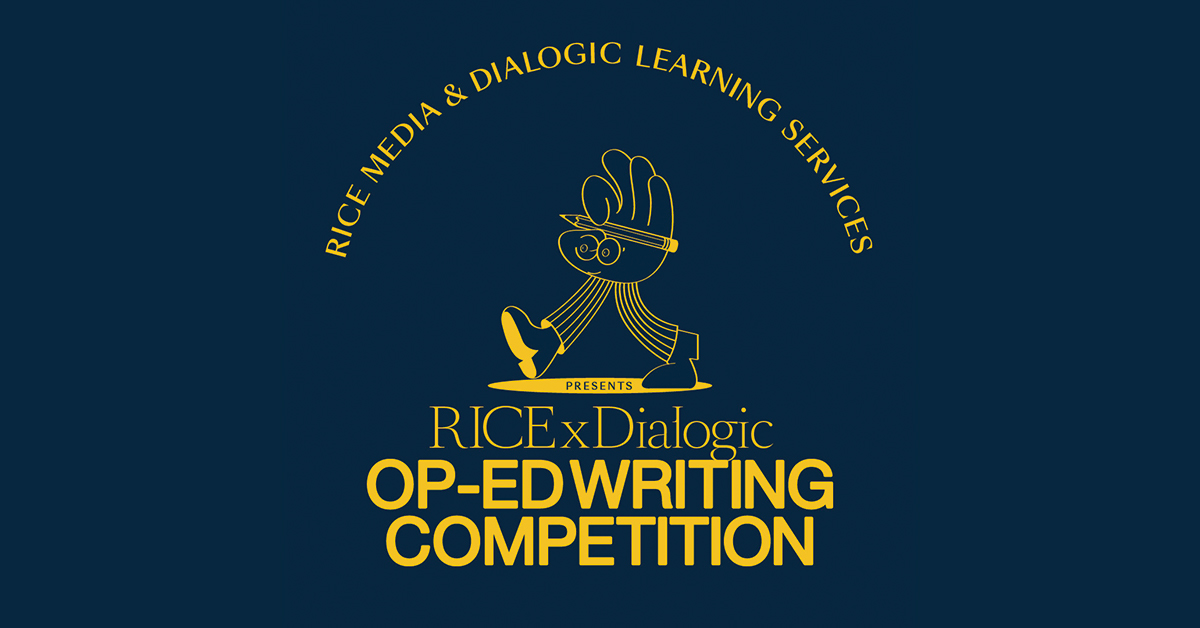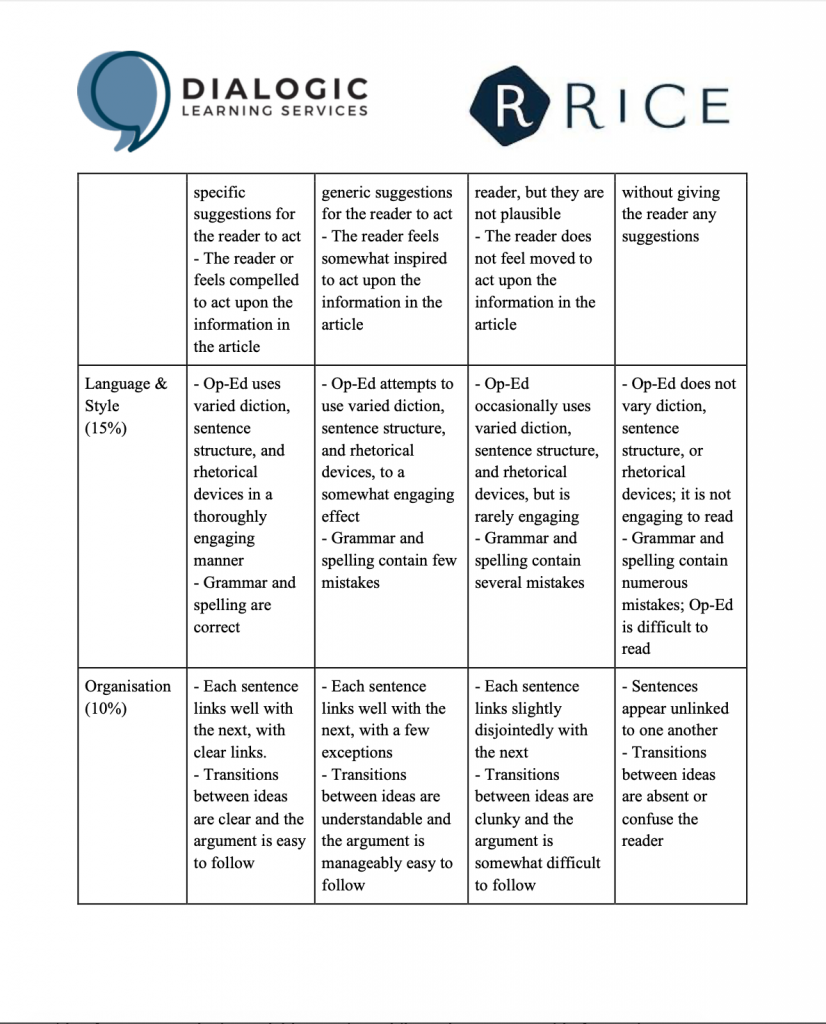In a world pressed by numerous issues at the local, national and international level, youth are speaking up and making their voices heard. In Singapore, three in four young people would like to contribute to policies of national significance, like healthcare and eldercare. In a world afflicted by COVID-19, our youth are stepping up to do their part for the national effort and care for vulnerable communities.
The opinions of today’s youth will shape the reality of tomorrow’s Singapore, and that of the world. We should listen to these opinions.
The Op-Ed format gives young writers the opportunity to express their opinion and share their viewpoints on a public platform. Rice Media and Dialogic Learning Services are collaborating to bring this platform to pre-university students, support them in their writing journey, and let their voices be heard.
Students are asked to submit an Op-Ed of 800-1,500 words that share the writer’s opinion on any topic. The objective of the Op-Ed is to persuade the reader to agree with the writer’s opinion. In writing the Op-Ed, writers should use one or more of the Methods of Persuasion detailed below. Submissions will be divided into two age brackets, Under-16 and 17-19, and judged separately
While students are permitted to write about any issue in society, they are reminded to be sensitive to the views and identities of others. Submissions must not be derogatory in tone towards any race, religion, gender, or other social groups.
To support students during the writing process, Rice Media and Dialogic Learning Services will be presenting an Op-Ed Masterclass on 20 June at 5 PM. Interested students can register at this link. Registration officially closes on 17 June; because slots are limited, registration may close sooner.
Submissions open on 10 June and close on 17 July. Students can make their submissions at this link.
Submissions will be judged by a team of professional writers, journalists and editors from Rice Media. Judging will be according to the rubric detailed below.
The top few submissions from each age bracket will be shortlisted on 19 July. These shortlisted Op- Eds will be featured on Rice Media’s website.
From 19-24 July, readers will be able to vote for their favourite article to receive a Reader’s Choice Award. On 26 July, the Reader’s Choice, along with the First, Second, and Third Prizes for each age bracket, will be announced. The First, Second, and Third Prize winners will be awarded $100, $50, and $25 respectively.
Op-Eds have several components that are essential to capturing the attention of readers and persuading them of the writer’s opinion.
Firstly, an Op-Ed must have a captivating, quirky, or startling title that makes the reader sit up and take notice. Once they open the article, the reader must find an introduction, or ‘hook’, that piques their curiosity and reels them in to read the rest of the article. Devices like surprising observations, rhetorical questions, and descriptive storytelling are often employed in hooks to great effect. Do take note that the hook must reflect the content of the piece: sensational, clickbait or inaccurate hooks can quickly turn readers against a writer once they realise the article isn’t what was promised.
To avoid this problem, the opinion of the writer must be clear and apparent in the Op-Ed. Writers must think carefully about how they phrase an opinion: too strong, and readers are turned off by the intensity; too weak, and the Op-Ed becomes generic or uninteresting. A writer usually develops a nuanced and interesting opinion only after much research and a good deal of thinking.
To argue for their opinion, writers should make use of one or more of the following Methods of Persuasion:
- Suggesting reasons or logic behind the argument
One of the most essential parts of any argument is the reasoning employed. If a reader is going to agree with the writer’s viewpoint, it must make sense. There are many kinds of sense that can be applied here: the writer’s view can be beneficial for economic reasons, for vulnerable groups, or for human health. The key question that must be answered is this: why is the writer’s viewpoint better than others?
- Citing expert opinions or supporting evidence
When reading Op-Eds, however, readers don’t simply consider ‘reasoning’ in isolation. By citing experts in the field, such as academic opinion & industry leaders, or supporting evidence, such as statistics & survey results, writers lend weight to their claims. Additionally, writers are demonstrating to the reader that they are well-read and knowledgeable on the topic, increasing the validity of the writer’s suggestions.
- Providing case studies or examples
Sometimes, arguments can appear theoretical and inapplicable to everyday scenarios. By providing case studies or examples, such as current affairs events which have demonstrated the writer’s viewpoint, writers can solidify their arguments. In this way, readers will be more convinced that a writer’s arguments ‘hold up’ in the real world, and that the writer’s perspectives will have practical significance.
- Comparing topic with analogous situations
Certain topics, while of interest to expert writers, could appear esoteric and un-relatable to readers. In such cases, writers may choose to compare their topic to an analogous situation that parallels the one they are exploring. In this way, objects and relationships in the analogous situation are likened to those in the writers’ topic, which sometimes has humorous effects, but helps a reader to understand the topic, and the writer’s perspective, much better.
- Describing personal experiences
Some writers may have arrived at their viewpoint after a particularly compelling personal experience. While there’s no substitute for the real thing, describing the event in vivid detail can help the reader empathise with the writer’s feelings, and thereby allow them to better understand and come around to the author’s viewpoint on a certain issue.
Lastly, the writer must answer a critical question: so what? Now that the writer has persuaded the reader through the strength of their argument, the reader should feel empowered to improve the issue or situation. However, readers only feel this way if they are given a clear call-to-action that they can perform; behaviours they can adopt or actions they can take to make things better. The call-to-action is the power of an Op-Ed writer. Its how they translate changes in the hearts and minds of their readers into changes in the world around them, through the actions of those readers.
Sign up for the Op-ed Masterclass here: https://forms.gle/Vy29cwbL1R4KTZq66
Dialogic Learning Services is a leading brand in co-curricular education that trains youth in 21st- century competencies. Dialogic specialise in a variety of academic activities such as debate, public speaking, journalism, Model United Nations, and case competitions. Dialogic provides a range of services like tailoring workshops for schools, providing coaching for extra-curricular activities, and providing private mentorship for students.









